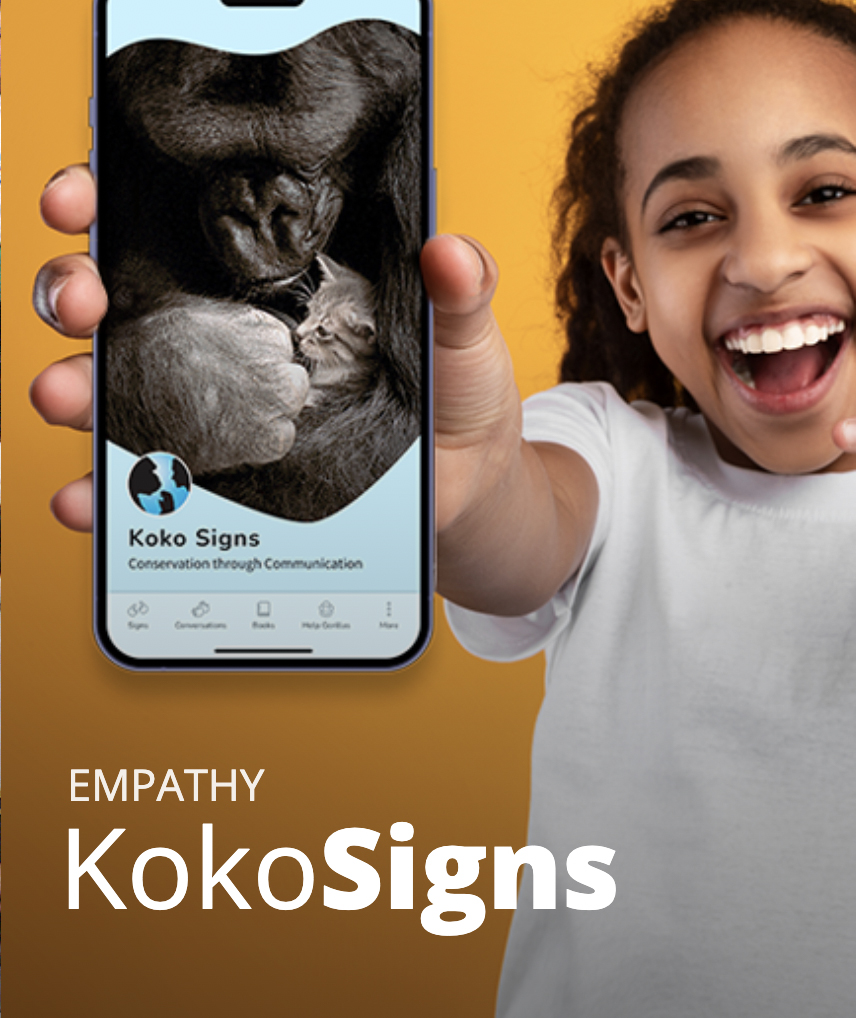
Goals
1) Help people of all ages learn to sign with Koko via a convenient phone app.
2) Teach many of Koko’s favorite signs (both ASL and natural gestures) demonstrated by Koko herself.
3) Enable people to learn many of Koko’s signs with help from Dr. Penny Patterson
4) Include real-world examples of Koko interacting with her caregivers and other animals, with and without sign language subtitles (for educational purposes)
5) Apply the app to facilitate “conservation through communication” especially by distribution in African gorilla habitat countries.
Download the Koko Signs app now!
Why this is Important
All gorillas use gestures to communicate. Koko just happened to be taught one of our gestural systems — American Sign Language (ASL). Thus, the KokoSigns app will make it possible for more captive gorillas to benefit from 2-way communication — by both teaching basic ASL to captive gorillas and, importantly, by decoding gorilla natural gestures. It also teaches a valuable language (ASL) to humans of all ages and nationalities — one that can transcend current language barriers, and has the potential to facilitate communication between the hearing and deaf communities.
Finally, interspecies communication fosters interspecies empathy, which is a pre-requisite for both lasting conservation and improved captive care. By learning Koko’s signs, you will be able to translate her videos without any help from subtitles, and thus begin to understand why we believe that gorillas are so intelligent — both intellectually and emotionally.
Approach
1) The Koko Signs app has 4 main sections:
Signs: Learn Koko’s favorite signs by looking them up by name, category or description. Each sign features a video clip of Koko demonstrating the way she does the sign, another clip of a native ASL signer (and former gorilla caregiver) Darlene Chan demonstrating the correct ASL version, and a third clip of Penny Patterson demonstrating the differences between Koko and ASL (if they exist).
Conversations: Short videos of Koko communicating with humans in sign language are provided as examples of her using multiple signs, and to give insight about her personality (both as an individual and as a gorilla).
When you look up a sign, you will automatically see all Conversation videos that include that sign, and when you click on the video, you’ll see a list of the signs that appear in the video with their timecodes. You can click on a Sign in the list and either jump to that Sign in the Conversation video, or learn the Sign by watching Koko (, Penny and/or Darlene) demonstrate it.
Conversely, you can look up Conversation videos, and learn all of the signs within each video.
Books: The Koko Signs app comes with several of our most popular books about Koko (and friends) loaded, as e-books: Koko’s Kitten, Koko’s Story, and Michael’s Dream. In addition to reading these books, as e-books, you can click on the Signs that appear as part of the book’s dialogue, and a popup of Koko demonstrating the sign will appear.
Gorillas: The Gorillas section has 2 subsections:
— Why Help Them? Describes the crises facing gorillas in both the wild, and in captive settings, and suggests solutions. One of the key solutions is to increase human empathy for gorillas by exposing more people (and gorillas) to interspecies communication.
— KokoCast: This is our new video podcast series, featuring interviews by Gorilla Foundation staff of world experts on gorillas (and other great apes), conservation and interspecies communication. Some of the KokoCasts feature students, who are invited to add their perspective, both through questions and suggestions about how to advance gorilla conservation and care, using interspecies communication and/or other tools at our disposal.
2) The app also has the following Special Features (in its “More …” menu):
- KokoGrams
- About the App
- About Koko
- About The Gorilla Foundation
- Donate
- Shop
- Contact Us
Progress
1) After a year of design and development with a world-class app development company, ArcTouch, the Koko Signs app (v1.0) was released in December 2023.
2) Thousands of people have been using the app, everywhere from the United States to Africa — especially in Cameroon and Uganda, where we have been running some pilot studies.
3) We have been working on several enhancements to the app, including adding more of Koko’s signs and conversations, new KokoCast interviews, and a downloadable version that makes a high-speed internet connection unnecessary.
4) In September 2024 we released Version 1.1 of KokoSigns, which included 2 new features: a) an “Offline Version” made possible by downloading all of the Signs and Conversations videos, as well as the Koko and Michael eBooks; and b) a new version of the KokoGram, which makes it possible to send Koko signs to friends and relatives in a way that makes it easy for them to download the app and send Koko signs back to you.
Download the Koko Signs app now!
Plans
1) We will be adding dozens of new signs and signing conversations in 2025, making the app richer in its ability to teach sign language, and to learn more about gorillas Koko, Michael and Ndume.
2) We will be adding more KokoCast interviews in 2025, including an interview with Dr. Anthony Rose, who initiated our African conservation program in the early 2000’s and who continues to be a source of creative content and inspiration.
3) We will continue to make the Koko Signs app more useful as a sign language learning tool, with self assessment quizes and learning trajectories, as well as a vehicle for increasing the use of interspecies communication in zoos and sanctuaries, where gorillas need better ways of expressing themselves, and teaching us about their needs — and more about how to save them in the wild.
4) Finally, we will be adding more conservation through communication content in the Gorillas section.

